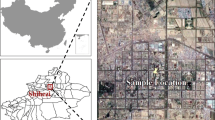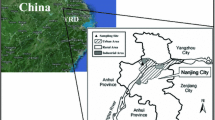Abstract
Previous studies on the characteristics, reactivity, and source distribution of volatile organic compounds (VOCs) mainly focused on large cities, while information regarding the source characteristics of VOCs in underdeveloped areas remains insufficient. Therefore, this study explored the concentration characteristics, source apportionment, and multiple effect pollution assessment of 106 VOCs observed from November 2019 to October 2020 in urban Tumushuke. Tumushuke is located in western China and is a representative city of southern Xinjiang. The results showed that the average VOCs concentration was 93.49 μg/m3. Alkanes (40.84 μg/m3) accounted for the largest proportion, followed by oxygen-containing compounds (21.06 μg/m3), halohydrocarbons (16.41 μg/m3), arenes (10.14 μg/m3), alkenes (3.51 μg/m3), and acetylene (1.52 μg/m3). Five main sources were identified based on the positive matrix factorization (PMF) model results: coal/biomass combustion (30.89%), transportation (26.06%), volatile solvents and fuels (18.43%), industry (12.76%), and plant emissions (11.86%). Alkanes, arenes, and alkenes exhibited the highest O3 formation potential, accounting for 40.60%, 26.14%, and 17.65%, respectively. Secondary organic aerosol formation was dominated by arenes, with the contribution rate reaching 96.67%. Halohydrocarbons and arenes significantly contributed to the toxic effects on the environment, accounting for 43.64% and 27.97%, respectively. Based on the multi-effect assessment, arenes and alkanes made the greatest contribution to the overall environmental impact, accounting for 54.72% and 20.10%, respectively. This study provides evidence to support local governments in formulating VOC control strategies in the future.





Source profiles derived from the PMF results



Similar content being viewed by others
Data availability
Some basic data, models, and code generated or used during the study appear in the submitted article. The rest date will be made available on reasonable request.
Abbreviations
- VOCs:
-
Volatile organic compounds
- PMF:
-
Positive matrix fractionization
- PAN:
-
Peroxyacetyl nitrate
- SOAs:
-
Secondary organic aerosols
- GC–MS/FID:
-
Gas chromatography-mass spectrometer-flame ionization detector
- MDLs:
-
Method detection limits
- BDL:
-
Below detection limit
- OFP:
-
Ozone formation potential
- SOAFP:
-
Secondary organic aerosol formation potential
- ETE:
-
Environmental toxic effects
- T/B:
-
Toluene/benzene ratio
- MIR:
-
Maximum ozone reaction activity
References
Carter WP, Pierce JA, Luo D (1995) Environmental chamber study of maximum incremental reactivities of volatile organic compounds. Atmos Environ 29:2499–2511
Derwent RG, Jenkin ME, Utembe SR (2010) Secondary organic aerosol formation from a large number of reactive man-made organic compounds. Sci Total Environ 408(16):3374–3381
Ding Y, Lu J, Liu Z, Li W, Chen J (2020) Volatile organic compounds in Shihezi, China, during the heating season: pollution characteristics, source apportionment, and health risk assessment. Environ Sci Pollut Res 27(14):16439–16450
Fu, S., M. Guo, J. Luo, D. Han, X. Chen, H. Jia, X. Jin, H. Liao, X. Wang, L. Fan and J. Cheng, 2020: Improving VOCs control strategies based on source characteristics and chemical reactivity in a typical coastal city of South China through measurement and emission inventory. Sci Total Environ, 744.
Han L, Chen L, Li K, Bao Z, Zhao Y, Zhang X, Azzi M, Cen K (2019a) Source Apportionment of Volatile Organic Compounds (VOCs) during Ozone Polluted Days in Hangzhou, China. Atmosphere 10:12
Han LX, Chen LH, Li KW, Bao ZE, Zhao YY, Zhang X, Azzi M, Cen KF (2019b) Source Apportionment of Volatile Organic Compounds (VOCs) during Ozone Polluted Days in Hangzhou, China. Atmosphere 10(12):18
He Z, Wang X, Ling Z, Zhao J, Guo H, Shao M, Wang Z (2019) Contributions of different anthropogenic volatile organic compound sources to ozone formation at a receptor site in the Pearl River Delta region and its policy implications. Atmospheric Chem Phys 19(13):8801–8816
Hu, R., G. Liu, H. Zhang, H. Xue, X. Wang and P. K. S. Lam, 2020: Odor pollution due to industrial emission of volatile organic compounds: A case study in Hefei, China. J Clean Prod, 246.
Huang YS, Hsieh CC (2019) Ambient volatile organic compound presence in the highly urbanized city: source apportionment and emission position. Atmos Environ 206:45–59
Huang YS, Hsieh CC (2020) VOC characteristics and sources at nine photochemical assessment monitoring stations in western Taiwan. Atmos Environ 240:14
Jing S-A, Gao Y-Q, Shen J-D, Wang Q, Peng Y-R, Li Y-J, Wang H-L (2020) Characteristics and Reactivity of Ambient VOCs in Urban Hangzhou, China. Huanjing Kexue 41(12):5306–5315
Li, Y., S. Yin, S. Yu, M. Yuan, Z. Dong, D. Zhang, L. Yang and R. Zhang, 2020: Characteristics, source apportionment and health risks of ambient VOCs during high ozone period at an urban site in central plain, China. Chemosphere, 250.
Liang, X., X. Sun, J. Xu and D. Ye, 2020: Improved emissions inventory and VOCs speciation for industrial OFP estimation in China. Sci Total Environ, 745.
Liu Z, Li N, Wang N (2016) Characterization and source identification of ambient VOCs in Jinan, China. Air Qual Atmos Health 9(3):285–291
Lv, D., S. Lu, X. Tan, M. Shao, S. Xie and L. Wang, 2021: Source profiles, emission factors and associated contributions to secondary pollution of volatile organic compounds (VOCs) emitted from a local petroleum refinery in Shandong. Environ Pollut, 274.
Morakinyo OM, Mukhola MS, Mokgobu MI (2020) Ambient Gaseous Pollutants in an Urban Area in South Africa: Levels and Potential Human Health Risk. Atmosphere 11:7
Niu ZZ, Kong SF, Zheng H, Yan Q, Liu JH, Feng YK, Wu J, Zheng SR, Zeng X, Yao LQ, Zhang Y, Fan ZW, Cheng Y, Liu X, Wu FQ, Qin S, Yan YY, Ding F, Liu W, Zhu KG, Liu DT, Qi SH (2021) Temperature dependence of source profiles for volatile organic compounds from typical volatile emission sources. Sci Total Environ 751:14
Saraga DE, Maggos TE, Sfetsos A, Tolis EI, Andronopoulos S, Bartzis JG, Vasilakos C (2010) PAHs sources contribution to the air quality of an office environment: experimental results and receptor model (PMF) application. Air Qual Atmos Health 3:225–234
Shao P, An JL, Xin JY, Wu FK, Wang JX, Ji DS, Wang YS (2016) Source apportionment of VOCs and the contribution to photochemical ozone formation during summer in the typical industrial area in the Yangtze River Delta, China. Atmos Res 176:64–74
Shao, M.,Yuan.B., Wang.M., Zeng.J.Y., Liu.Y. and Lu.S.H.,2020 : Volatile Organic Compounds in the Atmosphere: Sources and the Roles in Atmosphere Chemistry. Beijing, Science Press,423.
Simayi, M., Y. Shi, Z. Xi, J. Li, X. Yu, H. Liu, Q. Tan, D. Song, L. Zeng, S. Lu and S. Xie, 2020: Understanding the sources and spatiotemporal characteristics of VOCs in the Chengdu Plain, China, through measurement and emission inventory. Sci Total Environ, 714.
Tan QW, Liu HF, Xie SD, Zhou L, Song TL, Shi GM, Jiang WJ, Yang FM, Wei FS (2020) Temporal and spatial distribution characteristics and source origins of volatile organic compounds in a megacity of Sichuan Basin, China. Environ Res 185:13
Wang WJ, Xiong TT, Zhang W, Luo B, Wang DM, Jiang XC, Rao ZH, Jiang Y, Liu Y, Cheng H, Luo XJ, Fan MK, Gong ZJ (2020a) Observation and analysis of VOCs in nine prefecture-level cities of Sichuan Province, China. Environ Monit Assess 192(8):14
Wang W, Xiong T, Zhang W, Luo B, Wang D, Jiang X, Rao Z, Jiang Y, Liu Y, Cheng H, Luo X, Fan M, Gong Z (2020b) Observation and analysis of VOCs in nine prefecture-level cities of Sichuan Province, China. Environ Monit Assess 192:8
Wang, M., W. Qin, W. Chen, L. Zhang, Y. Zhang, X. Zhang and X. Xie, 2020: Seasonal variability of VOCs in Nanjing, Yangtze River delta: Implications for emission sources and photochemistry. Atmos Environ, 223.
Wei W, Ren YT, Yang G, Cheng SY, Han LH (2019) Characteristics and source apportionment of atmospheric volatile organic compounds in Beijing, China. Environ Monit Assess 191(12):11
Yan Y, Peng L, Li R, Li Y, Li L, Bai H (2017) Concentration, ozone formation potential and source analysis of volatile organic compounds (VOCs) in a thermal power station centralized area: A study in Shuozhou, China. Environ Pollut 223:295–304
Yang WQ, Zhang YL, Wang XM, Li S, Zhu M, Yu QQ, Li GH, Huang ZH, Zhang HN, Wu ZF, Song W, Tan JH, Shao M (2018) Volatile organic compounds at a rural site in Beijing: influence of temporary emission control and wintertime heating. Atmospheric Chem Phys 18(17):12663–12682
Yang Y, Liu X, Zheng J, Tan Q, Feng M, Qu Y, An J, Cheng N (2019) Characteristics of one-year observation of VOCs, NOx, and O-3 at an urban site in Wuhan, China. J Environ Sci 79:297–310
Ye L, Tai Q-Q, Yu H-M (2021) Characteristics and Source Apportionment of Volatile Organic Compounds (VOCs) in the Automobile Industrial Park of Shanghai. Huanjing Kexue 42(2):624–633
Zhang X, Ding X, Wang X, Talifu D, Wang G, Zhang Y, Abulizi A (2019) Volatile Organic Compounds in a Petrochemical Region in Arid of NW China: Chemical Reactivity and Source Apportionment. Atmosphere 10:11
Zhang, X., Y. Yin, J. Wen, S. Huang, D. Han, X. Chen and J. Cheng, 2019: Characteristics, reactivity and source apportionment of ambient volatile organic compounds (VOCs) in a typical tourist city. Atmos Environ 215.
Zheng H, Kong SF, Chen N, Niu ZZ, Zhang Y, Jiang SN, Yan YY, Qi SH (2021) Source apportionment of volatile organic compounds: Implications to reactivity, ozone formation, and secondary organic aerosol potential. Atmos Res 249:10
Zheng, H., S. Kong, Y. Yan, N. Chen, L. Yao, X. Liu, F. Wu, Y. Cheng, Z. Niu, S. Zheng, X. Zeng, Q. Yan, J. Wu, M. Zheng, D. Liu, D. Zhao and S. Qi, 2020: Compositions, sources and health risks of ambient volatile organic compounds (VOCs) at a petrochemical industrial park along the Yangtze River. Sci Total Environ, 703.
Zhou X, Li ZQ, Zhang TJ, Wang F, Wang FT, Tao Y, Zhang X, Wang FL, Huang J (2019) Volatile organic compounds in a typical petrochemical industrialized valley city of northwest China based on high-resolution PTR-MS measurements: Characterization, sources and chemical effects. Sci Total Environ 671:883–896
Funding
This work was supported by the National Natural Science Foundation of China [grant number 21866029]; Young and Middle-aged Science and Technology Innovation Leading Talent Project of the Eighth Division [grant number 2020RC05]; “Strong youth” Key Talents of Scientific and Technological Innovation of Xinjiang Construction Crops [grant number 2021CB04].
Author information
Authors and Affiliations
Corresponding authors
Ethics declarations
Conflict of interest
The authors declare no competing interests.
Additional information
Publisher's note
Springer Nature remains neutral with regard to jurisdictional claims in published maps and institutional affiliations.
Highlights
The current status of VOCs in southern Xinjiang.
VOCs based on multi-dimensional evaluation.
Arenes provided the greatest contributions to the comprehensive environmental impact.
Rights and permissions
About this article
Cite this article
Liu, X., Lu, J., Li, W. et al. Characterization, source apportionment, and assessment of volatile organic compounds in a typical urban area of southern Xinjiang, China. Air Qual Atmos Health 15, 785–797 (2022). https://doi.org/10.1007/s11869-021-01133-4
Received:
Accepted:
Published:
Issue Date:
DOI: https://doi.org/10.1007/s11869-021-01133-4




